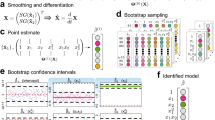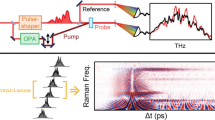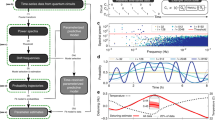Abstract
Imperfect knowledge of the times at which ‘snapshots’ of a system are recorded degrades our ability to recover dynamical information, and can scramble the sequence of events. In X-ray free-electron lasers, for example, the uncertainty—the so-called timing jitter—between the arrival of an optical trigger (‘pump’) pulse and a probing X-ray pulse can exceed the length of the X-ray pulse by up to two orders of magnitude1, marring the otherwise precise time-resolution capabilities of this class of instruments. The widespread notion that little dynamical information is available on timescales shorter than the timing uncertainty has led to various hardware schemes to reduce timing uncertainty2,3,4. These schemes are expensive, tend to be specific to one experimental approach and cannot be used when the record was created under ill-defined or uncontrolled conditions such as during geological events. Here we present a data-analytical approach, based on singular-value decomposition and nonlinear Laplacian spectral analysis5,6,7, that can recover the history and dynamics of a system from a dense collection of noisy snapshots spanning a sufficiently large multiple of the timing uncertainty. The power of the algorithm is demonstrated by extracting the underlying dynamics on the few-femtosecond timescale from noisy experimental X-ray free-electron laser data recorded with 300-femtosecond timing uncertainty1. Using a noisy dataset from a pump-probe experiment on the Coulomb explosion of nitrogen molecules, our analysis reveals vibrational wave-packets consisting of components with periods as short as 15 femtoseconds, as well as more rapid changes, which have yet to be fully explored. Our approach can potentially be applied whenever dynamical or historical information is tainted by timing uncertainty.
This is a preview of subscription content, access via your institution
Access options
Subscribe to this journal
Receive 51 print issues and online access
$199.00 per year
only $3.90 per issue
Buy this article
- Purchase on Springer Link
- Instant access to full article PDF
Prices may be subject to local taxes which are calculated during checkout




Similar content being viewed by others
References
Glownia, J. M. et al. Time-resolved pump-probe experiments at the LCLS. Opt. Express 18, 17620–17630 (2010)
Gahl, C. et al. A femtosecond X-ray/optical cross-correlator. Nature Photon. 2, 165–169 (2008)
Löhl, F. et al. Electron bunch timing with femtosecond precision in a superconducting free-electron laser. Phys. Rev. Lett. 104, 144801 (2010)
Harmand, M. et al. Achieving few-femtosecond time-sorting at hard X-ray free-electron lasers. Nature Photon. 7, 215–218 (2013)
Coifman, R. R. et al. Geometric diffusions as a tool for harmonic analysis and structure definition of data: diffusion maps. Proc. Natl Acad. Sci. USA 102, 7426–7431 (2005)
Giannakis, D. & Majda, A. J. Nonlinear Laplacian spectral analysis for time series with intermittency and low-frequency variability. Proc. Natl Acad. Sci. USA 109, 2222–2227 (2012)
Berry, T., Cressman, R., Gregurić-Ferenček, Z. & Sauer, T. Time-scale separation from diffusion-mapped delay coordinates. SIAM J. Appl. Dyn. Syst. 12, 618–649 (2013)
Aubry, N., Guyonnet, R. & Lima, R. Spatiotemporal analysis of complex signals: theory and applications. J. Stat. Phys. 64, 683–739 (1991)
Packard, N., Crutchfield, J., Farmer, J. & Shaw, R. Geometry from a time series. Phys. Rev. Lett. 45, 712–716 (1980)
Takens, F. in Dynamical Systems and Turbulence, Warwick 1980 (eds Rand, D. A. & Young, L.-S. ) Vol. 898 Lecture Notes in Mathematics (eds Dold, A. & Eckmann, B. ) 366–381 (Springer, 1981)
Sauer, T., Yorke, J. A. & Casdagli, M. Embedology. J. Stat. Phys. 65, 579–616 (1991)
Giannakis, D. & Majda, A. J. Comparing low-frequency and intermittent variability in comprehensive climate models through nonlinear Laplacian spectral analysis. Geophys. Res. Lett. 39, L10710 (2012)
Dashti, A. et al. Trajectories of the ribosome as a Brownian nanomachine. Proc. Natl Acad. Sci. USA 111, 17492–17497 (2014)
Stark, J., Broomhead, D. S., Davies, M. E. & Huke, J. Delay embeddings for forces systems. II. Stochastic forcing. J. Nonlinear Sci. 13, 519–577 (2003)
Pellegrini, C. & Stohr, J. X-ray free-electron lasers—principles, properties and applications. Nucl. Instrum. Methods Phys. Res. A 500, 33–40 (2003)
Stapelfeldt, H. & Seideman, T. Colloquium: aligning molecules with strong laser pulses. Rev. Mod. Phys. 75, 543–557 (2003)
Rudenko, A. et al. Real-time observation of vibrational revival in the fastest molecular system. Chem. Phys. 329, 193–202 (2006)
Coifman, R. R., Shkolnisky, Y., Sigworth, F. J. & Singer, A. Graph Laplacian tomography from unknown random projections. IEEE Trans. Image Process. 17, 1891–1899 (2008)
Schmidt, M. et al. Fragment-emission patterns from the Coulomb explosion of diatomic molecules in intense laser fields. Phys. Rev. A 60, 4706–4714 (1999)
Voss, S. et al. High resolution kinetic energy release spectra and angular distributions from double ionization of nitrogen and oxygen by short laser pulses. J. Phys. B 37, 4239–4257 (2004)
Pavičić, D., Lee, K. F., Rayner, D. M., Corkum, P. B. & Villeneuve, D. M. Direct measurement of the angular dependence of ionization for N2, O2, and CO2 in intense laser fields. Phys. Rev. Lett. 98, 243001 (2007)
Guo, W., Zhu, J., Wang, B., Wang, Y. & Wang, L. Angular distributions of fragment ions of N2 in a femtosecond laser field. Phys. Rev. A 77, 033415 (2008)
Eberhardt, W., Stohr, J., Feldhaus, J., Plummer, E. W. & Sette, F. Correlation between electron emission and fragmentation into ions following soft-X-ray excitation of the nitrogen molecule. Phys. Rev. Lett. 51, 2370–2373 (1983)
Bocharova, I. A. et al. Time-resolved Coulomb-explosion imaging of nuclear wave-packet dynamics induced in diatomic molecules by intense few-cycle laser pulses. Phys. Rev. A 83, 013417 (2011)
De, S. et al. Following dynamic nuclear wave packets in N2, O2, and CO with few-cycle infrared pulses. Phys. Rev. A 84, 043410 (2011)
Timmers, H. et al. Coherent electron hole dynamics near a conical intersection. Phys. Rev. Lett. 113, 113003 (2014)
Dawber, G. et al. Threshold photoelectrons coincidence spectroscopy of doubly-charged ions of nitrogen, carbon monoxide, nitric oxide and oxygen. J. Phys. B 27, 2191–2209 (1994)
Meyer, K. et al. Noisy optical pulses enhance the temporal resolution of pump-probe spectroscopy. Phys. Rev. Lett. 108, 098302 (2012)
Jerri, A. J. The Shannon sampling theorem—its various extensions and applications: a tutorial review. Proc. IEEE 65, 1565–1596 (1977)
Acknowledgements
We thank P. Bucksbaum, J. M. Glownia and A. Natan for experimental data and comments on an earlier version of the manuscript, and acknowledge discussions with A. Dashti, D. Giannakis, A. Hosseinizadeh, A. Rudenko, M. Schmidt and P. Schwander. The research conducted by A.O. and R.F. was supported by the US Department of Energy, Office of Science, Basic Energy Sciences under award DE-SC0002164 (algorithm design and development, and data analysis), and by the US National Science Foundation under awards STC 1231306 (numerical trial models) and 1551489 (underlying analytical models). The research conducted by T.S. and S.R. was supported by the US Department of Energy, Office of Science, Basic Energy Sciences under award DE-FG02-04ER15612. T.S. thanks the Hamburg Centre for Ultrafast Imaging for a Mildred Dresselhaus Visiting Professorship.
Author information
Authors and Affiliations
Contributions
A.O. proposed the approach. R.F. and A.O. developed the algorithm architecture. R.F. implemented the algorithm and, together with A.O., obtained results from experimental data. A.O. and R.S. interpreted the experimental results. S.R. and T.S. performed simulations of impulsive molecular alignment and provided expert advice. A.M.H., O.V. and R.S. performed quantum-mechanical calculations.
Corresponding author
Ethics declarations
Competing interests
The authors declare no competing financial interests.
Supplementary information
Supplementary Information
This file contains Supplementary Text and Data, Supplementary Figures 1-10 and Supplementary References. (PDF 2080 kb)
Rights and permissions
About this article
Cite this article
Fung, R., Hanna, A., Vendrell, O. et al. Dynamics from noisy data with extreme timing uncertainty. Nature 532, 471–475 (2016). https://doi.org/10.1038/nature17627
Received:
Accepted:
Published:
Issue Date:
DOI: https://doi.org/10.1038/nature17627
This article is cited by
-
Coherent correlation imaging for resolving fluctuating states of matter
Nature (2023)
-
Few-fs resolution of a photoactive protein traversing a conical intersection
Nature (2021)
-
Electron-ion coincidence measurements of molecular dynamics with intense X-ray pulses
Scientific Reports (2021)
-
Clocking Auger electrons
Nature Physics (2021)
-
Science in the age of machine learning
Nature Reviews Physics (2020)
Comments
By submitting a comment you agree to abide by our Terms and Community Guidelines. If you find something abusive or that does not comply with our terms or guidelines please flag it as inappropriate.



